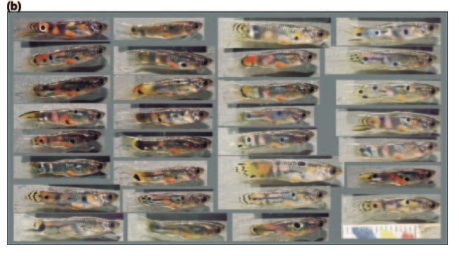Animal Behavior
Biology 342 Fall 2010
Week 7
Lateralization of Male Display
LINK TO LAB HANDOUT
GENERAL EXPECTATIONS
The purpose of the today's lab is to determine the effect of the immediate environment on mate choice by female guppies. There are three overlapping theories to explain the evolution of mate choice, "the Direct Benefit Hypothesis", "the Good Genes Hypothesis", the "Runaway Selection Hypothesis" (also known as "the sexy sons hypothesis"). There are actually more than three, but these are the main three. If you do not remember them from introductory biology you will want to review them before coming to lab. In Essential Animal Behavior, read pg 169 - 177, or refer to Alcock for a more rigorous explanation.

In 1989 Long and Houde demonstrated that female guppies prefer orange. The evolutionary reason for this preference is still debated. Rodd et al., 2001 provides a rigorous experimental study that suggest this signal evolved as a sensory trap. Morell 2002 provides a brief summary of that rigorous study (which you might want to read before coming to lab). Dugatkin and Godin_1998 provides a genearl overview of guppy mate choice.
During lab you will become familiar
with measuring matechoice preference.
You will also learn how to use ImageJ,
freely available software, that allows for complex image analysis.
We will use this software to quantify the amount of orange and blue on our
guppies.

For additional ideas for independent projects I suggest reading
Gross et al, 2007 which demonstrates a side preference for male display.
Alexander And Breeden
2004 demonstrates how mate choice could play a
role in maintaining species boundaries.
More detailed suggestions are provided at the end of the handout.
TO BE EVALUATED
A one page writeup completed with your partner.
Additional Reading (links will be created soon)
Alexander, H. J and Breden, F. (2004) Sexual isolation and extreme morphological divergence in the Cumana guppy: a possible case of incipient speciation. J. Evol.Biol. 17:1238-1254.
Andersson, M. (1994) Sexual selection. Princeton: Princeton University Press. This book is considered the modern reference guide for work on sexual selection.
Bateman, A.J., (1948) Intra-sexual selection in Drosophila. Heredity 2, 349–368.
Houde, A. E. (1997) Sex, color and mate choice in guppies. Princeton University Press.
Dugatkin., L.A. and Godin, J.G.J. (1998) How Females Choose their Mates Scientific American 56-61.
Gross, M.R., Suk, Y.Y., Robertson, C.T. 2007 Courtship and genetic quality: asymmetric males show their best side. Poc. Roc. Soc. B
Lens, L., Van Dongen, S., Kark, S., and Matthysen, E. (2002) Fluctuating asymmetry as an indicator of fitness: can we bridge the gap between studies? Biol Rev. 77:27-38.
Morell, V. (2002) Guppy Sex and Gluttony Guided by Orange Glow. Science 295 :1816b. & see response letters Science 296:847-848.
Neff, D. Bryan., Pitcher, E. Trevor. (2003) Multiple mating and sequential mate choice in guppies: females trade up. The Royal Society., p1623
Panhuis, T.M., Butlin, R., Zuk, M., and Tregenza, T. (2001) Sexual selection and speciation. TREE 16:364-371.
Rodd, F.H., Hughes, K.A., Grether, G.F. and Baril, C.T (2002) A possible non-sexual origin of mate preference: are male guppies mimicking fruit? Proc. Roc. Soc. B 269:475-481.(and the response)